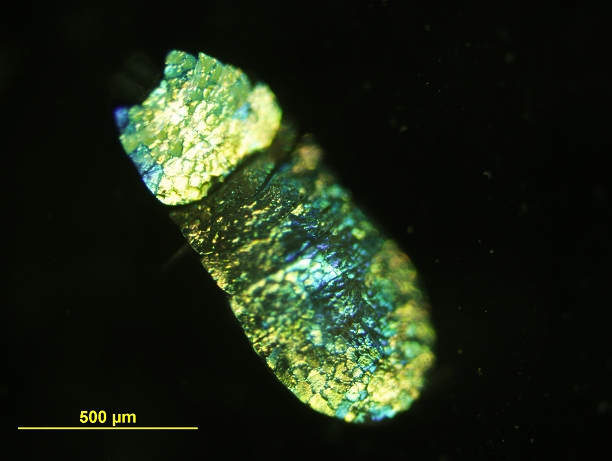Biogenic crystals are abundant in both the plant and animal kingdoms. Often, these can have an optical function. Together with the groups of Profs. Lia Addadi, Steve Weiner and Ben Palmer we have been studying some of these systems using a combination of structural and optical characterization tools.
Anhydrous guanine crystals form some of the most efficienct natural dielectric reflectors, and are responsible to the reflectivity of fish scales as well as to that of various marine organisms. The intricate relation between the structure (and particularly the local order) and the optical properties of these is studied using correlated optical and cryo-SEM measurements, and shows how well-designed these biological reflectors are. You can get an idea about the richness of guanine-based reflectors from the following reflectance image of a Sapphirina Metallina copepod.

Some of the most sophisticated biogenic crystal constructs can be found in the visual systems of marine animals. Due to the low index contrast between the fluid inside the eye and water ourside it, some marine animals have developed visual systems which rely heavily on reflection rather than on refraction. We have recently studied the eyes of scallops, of crayfish and of zebrafish, where diverse functional roles are taken by biogenic crystals and unique optical structures, such as highly birefringent spherulite opals, never studied previously in an artificial context, can be found. For more information, see our review paper on this topic [1].
One of the unique properties of all these systems is the exploitation of the extreme birefringence in organic crystals to outperform what is possible with isotropic materials. We are now developing synthetic metods to reproduce some of these materials and their analogs using in vitro crystallization.
Recent publications
-
B. A. Palmer, D. Gur, S. Weiner, L. Addadi, D. Oron, “The Organic Crystalline Materials of Vision: Structure-function Considerations from the Nanometer to the Millimeter scale”, Adv. Mat. 1800006 (2018).
-
V. J. Yallapragada, D. Oron, “Optical properties of spherulite opals”, Optics Letters 44, 5860 (2019).
-
B. A. Palmer, V. J. Yallapragada, N. Schiffmann, E. Merary Wormser, N. Elad, E. D. Aflalo, A. Sagi, S. Weiner, L. Addadi, D. Oron, “Highly Reflective Biogenic Materials from Core-Shell, Birefringent Nanospheres”, Nature Nanotechnology 15, 138 (2020).
-
L. M. Beck, V. J. Yallapragada, A. Upcher, B. A. Palmer, L. Addadi, D. Oron, “Measuring the optical properties of nanoscale biogenic spherulites”, Optics Express 29, 20863 (2021).
-
T. Lemcoff, L. Alus, J. S. Haataja, A. Wagner, G. Zhang, M. J. Pavan, V. J. Yallapragada, S. Vignolini, D. Oron, L. Schertel, B. A. Palmer, “Brilliant Whiteness in Shrimp from Ultra-Thin Layers of Birefringent Nanospheres”, Nature Photonics 17, 485 (2023).

